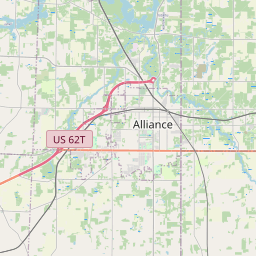Spanish American War Veterans
Historical marker location:
Alliance, Ohio
( Memorial is on Vine Street (Cemetery entrance).)







© OpenStreetMap contributors
Loading...
Searching for other points of interest within 3 miles of this location.The Cleveland Museum of Art, located in Cleveland, Ohio, is one of the largest and most prestigious art museums in the United States. It has a collection of more than 61,000 works of art, including works by Pablo Picasso, Vincent van Gogh, and Rembrandt.
About Stark County
Stark County Timeline
Stark County, Ohio has a rich history dating back to the early 19th century. The area was originally inhabited by Native American tribes, including the Delaware and Wyandot tribes. European settlers began arriving in the late 18th century, with the establishment of settlements such as Canton, Massillon, and Alliance.
During the early 1800s, Stark County experienced rapid growth and development. The completion of the Ohio and Erie Canal in 1827 provided an economic boost, as it connected the region to other parts of Ohio and allowed for easier transportation of goods. This led to the expansion of industries such as manufacturing, agriculture, and coal mining.
Stark County played a significant role in the abolitionist movement and the Underground Railroad. Many residents were active in helping enslaved individuals escape to freedom, and local landmarks like the Wesleyan Methodist Church in East Canton served as safe havens for fugitive slaves.
In the 20th century, Stark County became known for its thriving steel and manufacturing industries. Companies like Timken Steel, Republic Steel, and Hoover Company contributed to the county's economic growth and development. However, like many other industrial towns, Stark County experienced a decline in these industries in the latter part of the century, leading to changes in the local economy.
Today, Stark County is a diverse and vibrant community with a mix of urban and rural areas. It is home to various cultural and historical attractions, including the Pro Football Hall of Fame, the William McKinley Presidential Library and Museum, and the Canton Museum of Art. The county continues to evolve and adapt, embracing new industries and opportunities while cherishing its deep historical roots.
During the early 1800s, Stark County experienced rapid growth and development. The completion of the Ohio and Erie Canal in 1827 provided an economic boost, as it connected the region to other parts of Ohio and allowed for easier transportation of goods. This led to the expansion of industries such as manufacturing, agriculture, and coal mining.
Stark County played a significant role in the abolitionist movement and the Underground Railroad. Many residents were active in helping enslaved individuals escape to freedom, and local landmarks like the Wesleyan Methodist Church in East Canton served as safe havens for fugitive slaves.
In the 20th century, Stark County became known for its thriving steel and manufacturing industries. Companies like Timken Steel, Republic Steel, and Hoover Company contributed to the county's economic growth and development. However, like many other industrial towns, Stark County experienced a decline in these industries in the latter part of the century, leading to changes in the local economy.
Today, Stark County is a diverse and vibrant community with a mix of urban and rural areas. It is home to various cultural and historical attractions, including the Pro Football Hall of Fame, the William McKinley Presidential Library and Museum, and the Canton Museum of Art. The county continues to evolve and adapt, embracing new industries and opportunities while cherishing its deep historical roots.
Stark County Timeline
This timeline provides a glimpse into the major events and milestones that have shaped the history of Stark County, Ohio.
- 1809 - Stark County is founded.
- 1825 - Canton, the county seat, is incorporated.
- 1833 - The Ohio and Erie Canal reaches Canton, bringing economic growth to the area.
- 1861-1865 - Stark County sends many soldiers to fight in the American Civil War.
- 1892 - The Pro Football Hall of Fame is established in Canton.
- 1920 - The first professional football league, the American Professional Football Association (later renamed the National Football League), is founded in Canton.
- 1940s-1950s - Stark County experiences industrial growth as manufacturing and steel production expand.
- 1960s-1970s - Economic decline occurs as the manufacturing industry declines.
- 1990 - The Timken Company, a major employer in the area, celebrates 100 years of operation in Stark County.
- 2000s - Efforts to revitalize downtown Canton begin, including the construction of the Pro Football Hall of Fame Village.